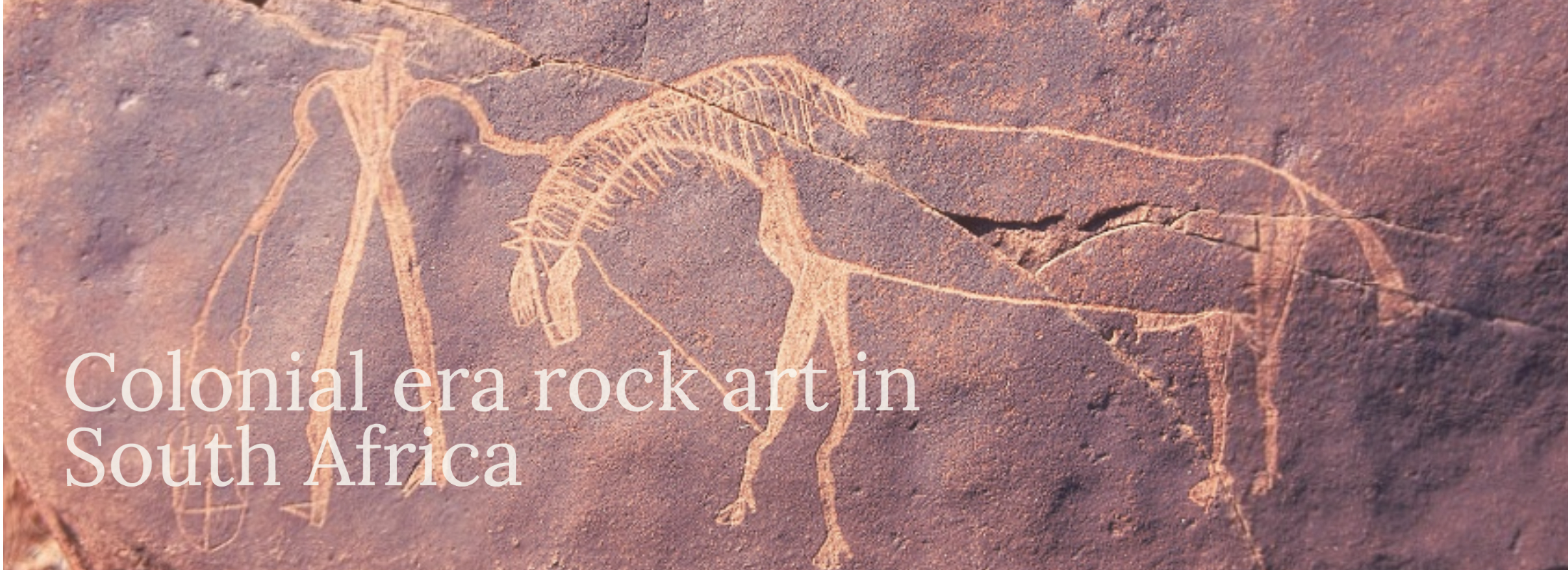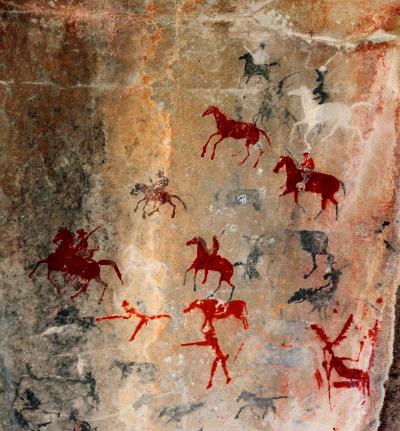
Easily recognised by depictions of people with colonial era items and animals - including guns, horses and European-style clothing – colonial era rock art was once thought to be the work of San painters capturing the arrival of European colonists on the landscape.
 When the informed approach, wherein the use of recorded beliefs of San people was used to decipher rock art, was developed, rock art researchers believed that the San painters incorporated the colonists into their cosmological beliefs. Accordingly, the Europeans were understood to be malignant forces that could be fought in both the spirit world by shamans as well as on the landscape.
When the informed approach, wherein the use of recorded beliefs of San people was used to decipher rock art, was developed, rock art researchers believed that the San painters incorporated the colonists into their cosmological beliefs. Accordingly, the Europeans were understood to be malignant forces that could be fought in both the spirit world by shamans as well as on the landscape.
More recent research, however, has made greater use of historical texts, written by settlers, travellers and missionaries, to gain a more complete understanding of these groups, an understanding which makes greater sense when read alongside the appearance of the art. To begin with, these texts describe in great detail the resistance of groups to European colonisation. In many cases these groups were not just San, but also included Khoe, African farmers and even runaway slaves from the colony, as well as any mixture of these and their descendants. This mixed-nature is reflected in the art itself. The paintings are sometimes made with the fine-line technique characteristic of earlier San art. In other instances they are finger-painted, like the art of pastoralists and African farmers. They can also be painted in rough brushwork, and in some cases combine all three techniques into the same image!
A closer reading of historical texts also makes it clear that we cannot look at rock art images of people with horses, hats and guns or European-style dresses and be certain that they are indeed depictions of Europeans. Many Africans adopted these items and animals during the colonial period. That we so often see rock art of people with hats and guns riding horses, seemingly chasing livestock, makes sense when we consider that mixed groups of Africans often resisted colonial expansion by raiding the animals of European settlers.
Additionally, other-worldly animals, such as the rain animal found in earlier San art, are also often depicted in these images. Information from African sources reveals that the rain was called upon during livestock raids to assist the raiders as mist acted as a camouflage and the rain would wash away the tracks of animals that had been taken, making it very difficult for any pursuers to follow the resistors. We also see depictions of other animals that would be seemingly out of place were these images the simple depictions of events that actually took place. Baboons and ostriches, revered among African groups for their powers in theft and the ability to foresee danger, and ostriches for their powers in matters relating to escape, also appear in rock art panels relating to stock raids. The powers of these animals were called upon by ritual specialists within these mixed groups to assist with the raids and the creation of rock art was part of this process.
Change in the latter half of the nineteenth century
In the latter half of the nineteenth century the rock art of the Northern Sotho underwent a dramatic change. The intrusion of white settlers into the region brought taxes, land clearances and conflict. A series of wars to subdue Northern Sotho traditional leaders left many homeless and destitute. At this time whole communities fled to the hill areas. Many of the old initiation sites became refuge settlements. A new form of rock art developed at this time dominated by depictions of steam trains, soldiers, settlers and guns. The images capture a people's tragedy, but served a more important purpose. They poked fun at the troublesome new intruders and through this pointed humour served to overcome some of the terrible stresses of the times. The art marks the origins of protest art in northern South Africa - ordinary people protesting their right to land and self-determination, and fighting the destruction of their traditional structures and cultural values.

